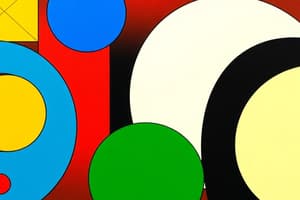Podcast
Questions and Answers
What factor can lead to the limit of the function not existing when $x$ approaches a?
What factor can lead to the limit of the function not existing when $x$ approaches a?
- Left tendency approaching infinity (correct)
- Both left and right tendencies approaching infinity (correct)
- Unique tendency at the point
- Right tendency approaching a finite limit
When using L'Hôpital's Rule, what indicates that the limit might be evaluated using the derivative approach?
When using L'Hôpital's Rule, what indicates that the limit might be evaluated using the derivative approach?
- The form is $0/0$ or $ rac{¥}{0}$ (correct)
- The limit at the point is equal to 0
- The numerator and denominator both approach zero (correct)
- Both functions are well defined at $x = a$
If $f(x)$ is well defined at $x = a$, what conclusion can you draw about the limit of $f(x)$ as $x$ approaches $a$?
If $f(x)$ is well defined at $x = a$, what conclusion can you draw about the limit of $f(x)$ as $x$ approaches $a$?
- lim $f(x)$ may not equal $f(a)$ (correct)
- lim $f(x)$ = $f(a)$
- lim $f(x)$ always equals to 0
- lim $f(x)$ does not exist
In what case would the limit of the function not exist despite the presence of derivatives?
In what case would the limit of the function not exist despite the presence of derivatives?
Which of the following indicates a valid use of L'Hôpital's Rule?
Which of the following indicates a valid use of L'Hôpital's Rule?
What must be true about the limits of $g(x)$ in the processes described?
What must be true about the limits of $g(x)$ in the processes described?
What does the term 'unique tendency' refer to when discussing limits?
What does the term 'unique tendency' refer to when discussing limits?
Which statement describes the process of limits involving exponential functions?
Which statement describes the process of limits involving exponential functions?
In which situation would differentiation of both the numerator and denominator continue until a limit is achieved?
In which situation would differentiation of both the numerator and denominator continue until a limit is achieved?
What indicates that further differentiation of the limit functions is necessary?
What indicates that further differentiation of the limit functions is necessary?
Flashcards are hidden until you start studying
Study Notes
Indeterminate Forms
- L'Hospital’s rule applies only to two indeterminate forms: 0/0 and ∞/∞.
- Indeterminate forms occur when direct substitution in limits leads to ambiguity, specifically:
- 0/0, ∞ - ∞, 1^∞, 0^0, ∞ * 0, ∞/∞.
Limit Evaluation Examples
- Example of limit leading to an indeterminate form:
- For lim (x → 2) of (x³ + 2x - 12)/(x² - 1), direct substitution yields 0/0.
- Application of L'Hospital's rule involves differentiating the numerator and denominator until the indeterminate form is resolved:
- Differentiating (x³ + 2x - 12) gives 3x² + 2, and (x² - 1) gives 2x.
- The limit becomes lim (x → 2) of (3x² + 2)/(2x) = 12/4 = 3.
Conditions for Limits
- If a limit does not exist due to different tendencies from the left and right sides, it indicates that the function does not approach any particular value.
- Example of a limit that does not exist:
- lim (x → 0) of x does not converge as it approaches -∞ from the left and +∞ from the right.
Function Definitions and Limits
- A function f(x) can be well-defined at x = a without having lim (x → a) = f(a).
- A well-defined function could still not possess a unique tendency near the point a, indicating possible limits approaching different values.
Differentiation Process
- To resolve indeterminate forms, one may repeatedly differentiate the numerator and denominator:
- Example: lim (x → a) of f(x)/g(x) may require further analysis if it continues to yield indeterminate forms.
- This differentiation method continues until reaching a determinate form or a limit that can be evaluated directly.
Studying That Suits You
Use AI to generate personalized quizzes and flashcards to suit your learning preferences.




